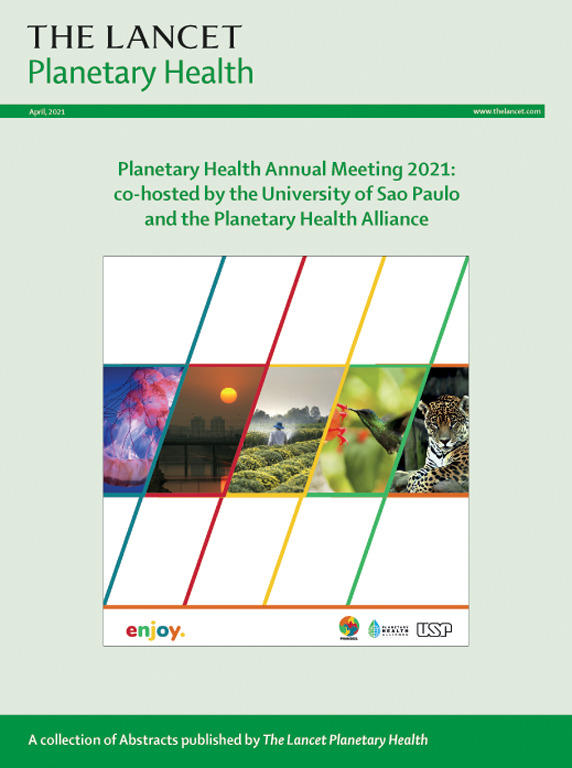估算低收入和中等收入国家因人为气候变化造成的与气温相关的出生体重不足的负担:一项回顾性多中心流行病学研究。
IF 24.1
1区 医学
Q1 ENVIRONMENTAL SCIENCES
引用次数: 0
摘要
背景:由于孕妇的生理状况,他们特别容易受到非最佳温度的影响。此外,怀孕是胎儿健康规划的关键时期。量化非最佳温度暴露的影响以及人为气候变化的影响对于减轻和适应与气候相关的健康风险至关重要。然而,对中低收入国家(LMICs)孕妇的研究还不够深入:我们利用 1990 年至 2018 年 31 个低收入和中等收入国家的 511 449 例新生儿的数据,将气候模拟(有人类活动强迫和无人类活动强迫)与时空分辨温度数据和出生体重记录联系起来。我们评估了热暴露和冷暴露(即 >90th 和 Findings:与最佳温度范围相比,孕期受热与几个地区出生体重不足风险增加有关:亚洲南部(几率比 1-41,95% CI 1-34-1-48)、非洲西部(1-12,1-02-1-24)和非洲东部(1-40,1-27-1-55)。在非洲中部(1-31,1-10-1-56)、非洲南部(1-18,1-02-1-36)和非洲东部(1-14,1-02-1-26),寒冷会增加出生体重不足的风险。在亚洲南部、非洲西部和非洲东部,人类活动导致的气候变化分别占与热相关的出生体重不足病例的 59-2%(95% CI 16-6-94-3)、89-0%(51-0-100-0)和 77-3%(27-0-100-0)。相反,在以寒冷为主的地区,人为气候变化减轻了出生体重不足的负担:我们的研究提供了人为气候变化对低收入和中等收入国家出生体重不足负担的量化估计。这些研究结果可为低收入和中等收入国家的气候减缓和适应战略提供参考,并有助于减少全球健康不平等现象:国家自然科学基金委员会本文章由计算机程序翻译,如有差异,请以英文原文为准。
Estimating the burden of temperature-related low birthweight attributable to anthropogenic climate change in low-income and middle-income countries: a retrospective, multicentre, epidemiological study
Background
Pregnant individuals are particularly susceptible to non-optimal temperatures due to their physiological status. Moreover, pregnancy is a crucial period for programming fetal health. Quantifying the impact of non-optimal temperature exposure and the contribution of anthropogenic climate change is crucial for mitigating and adapting to climate-related health risks. However, this has not been thoroughly studied in pregnant individuals in low-income and middle-income countries (LMICs).
Methods
Using data from 511 449 births across 31 LMICs from 1990 to 2018, we linked climate simulations (with and without anthropogenic forcing) to spatiotemporally resolved temperature data and birthweight records. We assessed the association between heat and cold exposure (ie, >90th and <10th percentile of temperature by region) during pregnancy and birthweight across different regions. We then used temperature simulations from both historically forced and natural-only forced climate models to estimate changes in exposure due to anthropogenic climate change and to quantify the burden of temperature-related low birthweight (ie, a birthweight <2500 g) attributable to anthropogenic climate change.
Findings
Heat exposure during pregnancy, compared with the optimal temperature range, was associated with an increased risk of low birthweight in several regions: southern Asia (odds ratio 1·41, 95% CI 1·34–1·48), western Africa (1·12, 1·02–1·24), and eastern Africa (1·40, 1·27–1·55). Cold exposure increased the risk of low birthweight in central Africa (1·31, 1·10–1·56), southern Africa (1·18, 1·02–1·36), and eastern Africa (1·14, 1·02–1·26). Anthropogenic climate change contributed to approximately 59·2% (95% CI 16·6–94·3), 89·0% (51·0–100·0), and 77·3% (27·0–100·0) of heat-related low birthweight cases in southern Asia, western Africa, and eastern Africa, respectively. Conversely, in regions where cold exposure was predominant, anthropogenic climate change reduced the burden of low birthweight.
Interpretation
Our study provides quantitative estimates of the contribution of anthropogenic climate change to the low birthweight burden in LMICs. These findings can inform strategies for climate mitigation and adaptation in LMICs and help reduce global health inequalities.
Funding
National Natural Science Foundation of China.
求助全文
通过发布文献求助,成功后即可免费获取论文全文。
去求助
来源期刊

Lancet Planetary Health
Multiple-
CiteScore
28.40
自引率
2.30%
发文量
272
审稿时长
8 weeks
期刊介绍:
The Lancet Planetary Health is a gold Open Access journal dedicated to investigating and addressing the multifaceted determinants of healthy human civilizations and their impact on natural systems. Positioned as a key player in sustainable development, the journal covers a broad, interdisciplinary scope, encompassing areas such as poverty, nutrition, gender equity, water and sanitation, energy, economic growth, industrialization, inequality, urbanization, human consumption and production, climate change, ocean health, land use, peace, and justice.
With a commitment to publishing high-quality research, comment, and correspondence, it aims to be the leading journal for sustainable development in the face of unprecedented dangers and threats.
 求助内容:
求助内容: 应助结果提醒方式:
应助结果提醒方式:


